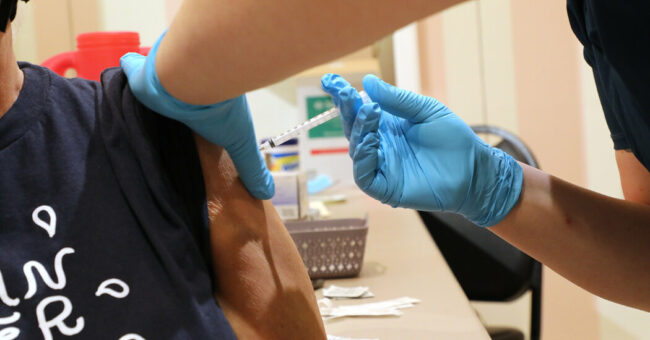Corporate America has entered the next phase of its effort to counter the spread of the coronavirus. Companies of 100 or more employees have until Jan. 4 to ensure all their workers are either fully vaccinated or submit to weekly testing and mandatory masking. The measure was announced by President Biden in September, and details were released on Nov. 4 by the Labor Department’s Occupational Safety and Health Administration. Some employers have already stepped forward to establish their own vaccine mandates, but many had been waiting for federal guidance. OSHA’s rule will affect some 84 million private sector workers across the country, including some 31 million who were believed to be unvaccinated.
Here are answers to some of the most commonly asked questions about what OSHA’s rule means for American workers and their employers.
What is OSHA’s new rule?
Private companies of 100 or more employees must require their workers to be fully vaccinated by Jan. 4 or submit to weekly coronavirus testing and mask-wearing while in the workplace. The deadline for employers to enforce the mask mandate is Dec. 5.
How will OSHA’s rule be enforced?
OSHA is expecting that the vast majority of workplaces will comply with its rule, but it will investigate complaints that workers raise. The agency has a whistle-blower system that allows workers to report any possible violations at their workplaces. The agency has tended to be short-staffed on inspectors, labor lawyers said, but it is likely to make enforcement of the rule a high priority.
What is the penalty for violations?
Companies that fail to comply with the rule may be subject to fines, according to an administration official. OSHA’s penalties are up to $13,653 per serious violation.
Which employers are covered by OSHA’s rule?
Any employer with 100 or more workers will be required to adhere to the rule. Some smaller businesses have voluntarily issued their own mandates for either coronavirus vaccines or weekly testing. A Gallagher survey of more than 500 businesses released in early November found that the number of employers requiring vaccinations had doubled since August, to 17 percent from 8 percent of its survey respondents.
OSHA is currently considering whether to extend the rule to employers with fewer than 100 workers.
Do part-timers and contractors count toward the 100-worker threshold?
All employees, including those working part time, count toward the threshold. Independent contractors do not.
Will the requirements apply to remote workers?
Tele-workers and people who work exclusively outdoors will not be required to be vaccinated or submit to weekly testing because OSHA’s rule is focused specifically on ensuring people’s protection against the coronavirus in the workplace. Employees who work part of the time in the office and the rest of the time remotely are required to follow the rule.
Which vaccines count toward the requirement?
Workers can get any vaccine listed for emergency use by the World Health Organization, which includes two doses of Moderna or Pfizer-BioNTech and one dose of Johnson & Johnson.
Who can claim an exemption? Who will determine those exceptions?
Employers are required to give two kinds of exemptions to the vaccine mandates: medical and religious. Exemptions for people with certain medical conditions are protected under the Americans with Disabilities Act. Many employers require people to present a doctor’s note to qualify for this exemption. Exemptions for people with sincerely held religious beliefs are protected under Title VII of the Civil Rights Act. So far, no major religion has banned its members from taking the coronavirus vaccine.
Can employees opt out through testing? Who will pay for those tests?
It will be up to employers to determine whether workers can opt out of getting vaccinated by submitting to coronavirus testing. If workers opt to be tested weekly instead of being vaccinated, they must also be masked in the workplace. OSHA does not require employers to pay for or provide tests, given that the vaccine is free and highly effective, but businesses may be required to pay under collective bargaining agreements or local laws.
Will employees be paid for the time it takes to get vaccinated?
Employers have to provide paid time off for their workers to get vaccinated, up to four hours, as well as sick leave for them to recover from side effects. They’re required to provide this leave starting Dec. 5.
How will employers verify that workers are vaccinated?
Employers are expected to keep documentation of their workers’ vaccination status, such as a copy of their vaccination cards or a signed and dated employee attestation.
Can employers fire workers who don’t comply?
The religious and medical exemptions will come into play here — but when it comes to people who do not have exemptions, employers are generally free to discipline people who don’t follow their rules. They may face pushback, though, under collective bargaining agreements.
How long will employers have to put the new standard into effect?
Employers need to act quickly: The deadline for workers to be fully vaccinated is Jan. 4. With many retail and logistics companies understaffed and overburdened, the January deadline will make it easier for them to face the holiday season.
What legal authority does OSHA have to create this rule?
The Occupational Safety and Health Act gives OSHA authority to respond quickly to emergency situations when workers are confronted with grave threats. Because of the serious threat posed by the pandemic, the agency has issued an emergency temporary standard allowing it to put in place this new rule. Labor lawyers say this is within OSHA’s legal authority. Still, the rule is likely to face challenges, and dozens of attorneys general have already threatened to sue.
“The pushback is going to be on the question of, ‘Is this an occupational hazard?’” said Doug Brayley, an employment lawyer at the law firm Ropes & Gray. “When you’ve got a virus circulating everywhere, is it within OSHA’s authority to regulate it as an occupational health matter? I think OSHA will prevail, but I’m not certain.”
www.nytimes.com
